Hi, everyone. One of my favourite parts of any election night's coverage on CNN is 'the big board', specifically when John King goes through a race's results and boldly proclaims "This is where the people are". Also, there is nothing quite like the drama of a statewide race in Missouri where the Republican is 5 or 6 points up, but you can see St. Louis is still out...
**TO THOSE THAT HAVE READ MY PREVIOUS DIARIES, THIS IS SIMILAR INFORMATION, BUT ARRANGED CHRONOLOGICALLY AND SKIPPING SOME STATES AND WRITEUP, FOCUSING ON STATES WITH STATE-WIDE RACES**
**TO THOSE THAT HAVE READ MY PREVIOUS DIARIES, THIS IS SIMILAR INFORMATION, BUT ARRANGED CHRONOLOGICALLY AND SKIPPING SOME STATES AND WRITEUP, FOCUSING ON STATES WITH STATE-WIDE RACES**
PART 1 HEREPART 2 HEREPART 3 HEREPART 4 HEREPART 5 HERE
Also, please drop by visit for the guys at Stochastic Democracy It looks like I'll be doing some live-blogging over there during Election Night, and they're looking like having a really cool system for calling elections that any numbers buff should check out.
**IF YOU'VE SEEN ALL MY MAPS BEFORE, PLEASE STAY AND COMMENT ANYWAY, WE CAN GET A LITTLE CHAT GOING ABOUT WHERE WE'LL ALL BE WATCHING IN ABOUT 24 HOURS**
However, other than the basics of 'Democrats live more in cities', it's tough to really get a sense of how a race is going to unfold based on what's shown on TV, especially when an important race in the Senate, of which there are several, get fairly little attention in the wake of a Presidential call.
So, I decided to try and help out myself, and by posting this, other Daily Kos readers, by calculating, for every county in the country, a partisan voting index. Think of this as the same as a regular PVI, only at a county level, relative to the overall state result, rather than at the CD-level relative to the overall national result. To do this, I took the results for the Democratic candidate in each county for the last two presidential races and the last two senate races and calculated by how much they differed from the overall state result for the Democrat in the same race.
For example:
2006 VA Senate - Statewide, Webb 49.6% - Rappahannock County, Webb 51.6%, for a rating of +2.0%
By averaging the results from these four races, weighting for the more recent, and weighting the Presidential race over the Senate races a little, I calculated each county's Blarghman County Voting Index (BCVI).
What does this mean, you ask? Well, basically, what it means is that as results come in, you can look at the BCVI values, or more appropriately, the maps I have created that show them, and figure out if the results yet to come favour the Democrat or the Republican. Also, they can give you an early idea of how a candidate is doing.
As in the example above, consider, Rappahannock County, VA. While it was 2 points more for Webb than the state overall, when the other races are factored in, it is about even with the state average. This is reflected in the fact that John Kerry earned 45.4% in the county, and 45.5% in the state.
So, if Rappahannock reports fairly early on Election Night (purely speculation on my part), and Obama is above 50%, it's a very good sign that he will have a good chance at winning the state. To me, this is fascinating stuff, and can really give a lot of input to avid political viewers like myself and many others here.
So, with just a little further ado, I am going to present some maps, along with some brief discussion, of the first 10 states alphabetically, with the maps shaded by BCVI value.
**IMPORTANT NOTES ABOUT MAPS AND ANALYSIS**
- Remember that these are a voting index, not a vote total. The maps depict how far from a STATE AVERAGE a Democrat is expected to be in a given county.
- These are based on data from past elections, and do not consider changes in turnout pattern in this election, nor demographic shifts since the last election. I don't see any way to realistically model these, so I must unfortunately ignore them.
- The number on each county represents it's percentage of overall state 2004 turnout, to give you a rough idea of, as John King puts it, "Where the people are".
- I don't live in any of these counties, and I never have, I'm a Canadian citizen, who is fascinated with the mathematics, statistics, polling, drama and scope of US elections. So if you have something you know about your area that I've mischaracterized, please let me and others know in the comments, and I'll try and fix it.
- Note, unsurprisingly, the deeper red indicate more Republican areas, with the deepest red indicating a Index value lower than -20. The same is true for deepest blue and Democratic counties above +20. White indicates counties that are plus or minus 2.5 from the state average.
- To see a map bigger, including the numbers at much higher quality, at least in Firefox, right click and select 'View Image'. For IE, I think you have to choose 'Save Image', then view it once you've downloaded it.
- Really, this is #1 again, but you can basically consider these maps as a 50-50 scenario, ie. "what if the Democrat and the Republican tied in state X?". For some blood-red and ocean-blue (what else is deep blue, anyone got anything?) states, these will look strange, if only because we aren't used to seeing maps where a Democrat is anywhere near 50% in, say, Idaho.
So, here we go, starting with 6:00 PM Eastern
**6:00 CLOSINGS**
Two states, the eastern halves of Indiana and Kentucky, with the presidential and senate races on display, respectively. This is where things are interesting. The area that I have talked about in the series is the eastern part of Kentucky, strong Democratic, heavily white areas of a nominally southern state. Obama should actually carry at least a few of these in the furthest east of the state, if he is performing as expected for a Presidential candidate. Lunsford will hope to be close, but being behind early is not a disaster. McCain will be ahead in Indiana, but don't panic, the most Democratic area will be still voting in the southwest, as well as swing areas in the southwest.
INDIANA
This page includes a map of county names
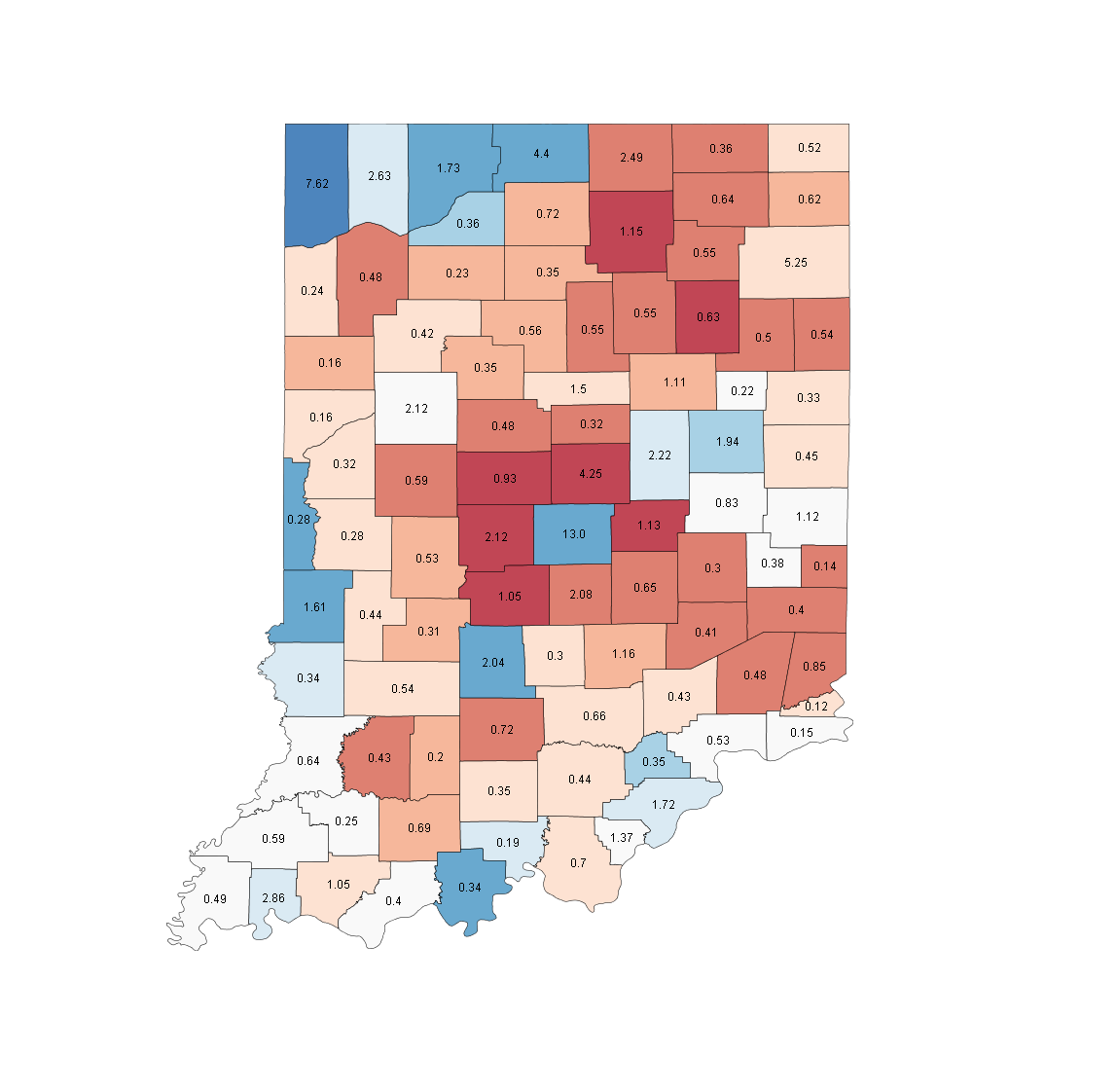
Races (538 Average/SSP Rating): President - Toss-up (O 48.5, M 49.6) Senate - None Governor - Thompson v. Daniels(i) (Likely R) House - IN-03 Montagano v. Souder(i) (Toss-up), IN-09, Hill(i) v. Sodrel (Likely D)
Counties to watch: There are three main swing areas in the state, and the difference between winning and losing them is found by comparing the 1996 Presidential and Governor's races at Dave Leip's Atlas.
The first is the southern 'fringe', a range of about a dozen counties with around 15% of the vote in the south of the state. Four of these are clustered together in the southwest, Gibson, Knox, Posey and Pike, the four white counties in the bottom left corner. All four of these were about even with Gore in 2000, but were a few points behind Kerry in 2004, and this represents a big strength area for Evan Bayh. Clinton carried all 4 in '96, but it wasn't enough to take the state. If the bottom edge of Indiana is red on election night, McCain will probably hold, but if it is blue, even if only by a point or two, things will be more interesting.
The second area is to the west centre, the white square labelled '2.12', Tippecanoe County, home to Purdue University. This is generally a dead even county with the overall state numbers, but even losing it didn't hurt Frank O'Bannon in '96. Given Obama's strength with younger voters, this could be a county that a youth surge puts into the blue column and helps shift the state overall.
The final area is the three pale counties gathered together in the East, Fayette, Henry and Wayne. These are generally around a point behind the Presidential candidates in the state, and though they are fairly small, they are fairly solid bellwethers. O'Bannon won two and won the state, Clinton was shut out and lost. While these do look like they have trended away from Democrats just a fraction since then, they should still be close. Painting these blue on the big board may be indicative of a showing that catapults Obama to a GE victory in the state.
IN-03 is a real surprise district under pressure, as it is the northeast corner, with only red counties, going to Bush by something like 65-35. The west is deep-red, but for a victory the battle will be in the southeast, Allen County.
KENTUCKY
This page includes a map of county names
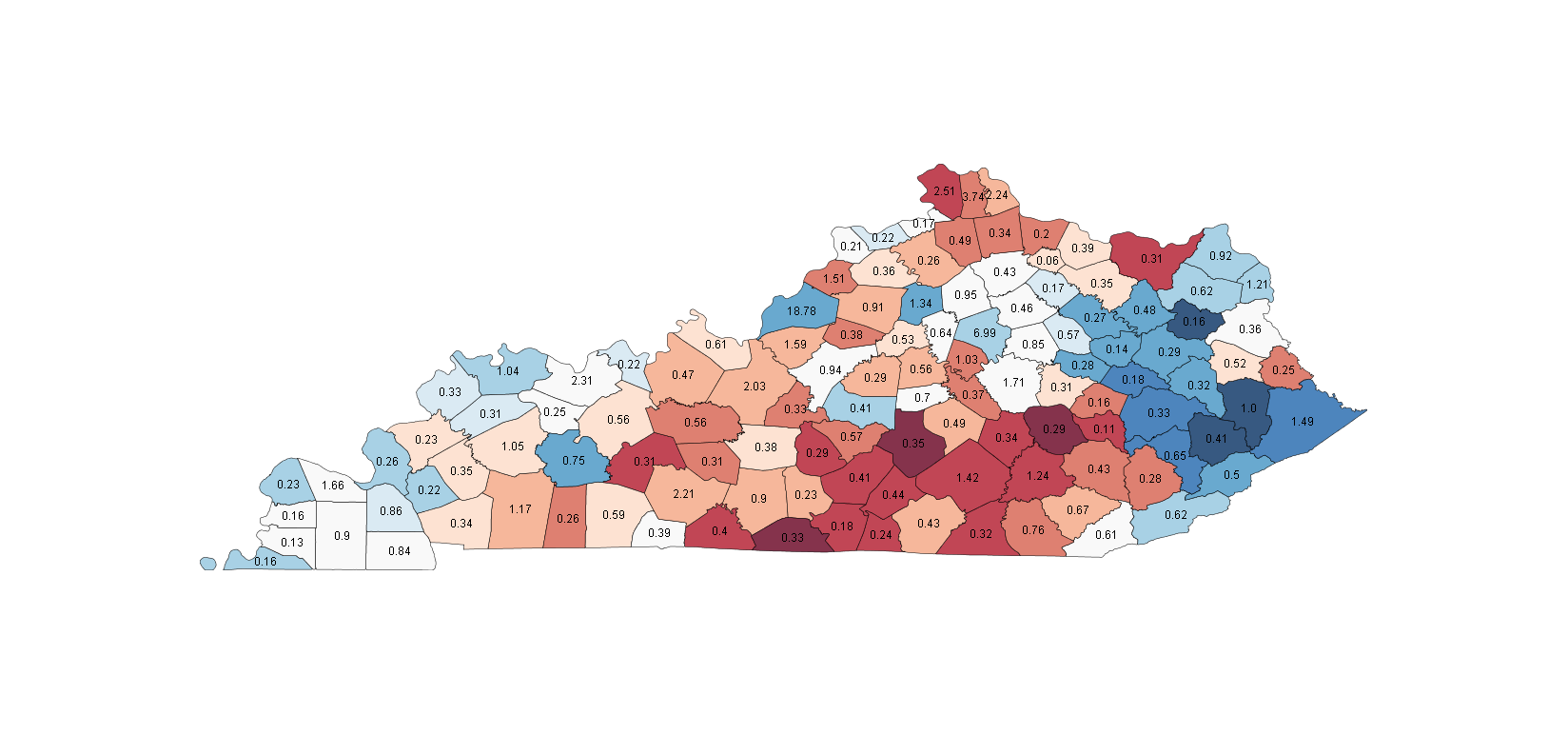
Races (538 Average/SSP Rating): President - Safe McCain (O 42.1, M 56.1) Senate - Lean Republican (D 46.7, R 50.9) House - KY-02, Boswell v. Guthrie (Lean R), KY-03, Yarmouth(i) v. Northup (Likely D)
Counties to watch: For Lunsford there are two main areas key to winning. First, he has to successfully 'seal in' Republican votes by winning a good chunk of the western tip of the state. This includes the swing county of McCracken, home to Paducah, right on the Illinois border.
The other important area surrounds the area of Lexington, which is itself contained in Fayette County, a pale blue county labeled 6.99 in the state's north-centre. This ring of white counties surrounding Lexington must go blue for Lunsford to have any chance, and preferably by at least a few points, as Mongiardo managed to win several without winning the state.
In the two House races, KY-03 covers Louisville itself, and Yarmouth is looking fairly safe there. KY-02 starts just south of the Louisville, and carries down through some fairly red area nearly to the Tennessee border. The two key areas will be the areas just outside Louisville and the sing county of Daviess on the west of the district (a white 2.31 county). Daviess is home to Owensboro, the third-largest city in the state, so building up margin there and in the Louisville area is key to claim the open seat.
**7:00 CLOSINGS** The Western parts of the two states above close, with calls likely in KY-PRES, but hopefully not in the other races we want. Most of Florida, excepting the panhandle closes, but remember that the panhandle is strongly Republican, so Obama must build a margin in the remainder of the state. Other closings are Georgia, the Townships of New Hampshire, South Carolina, Vermont and Virginia, of which the first and last loom largest.
FLORIDA
This page includes a map of county names

Races (538 Average/SSP Rating): President - Lean Obama (O 49.7, M 48.5) Senate - None House - FL-08 Grayson v. Keller(i) (Tossup), FL-13 Jennings v. Buchanan(i) (Likely R), FL-18 Taddeo v. Ros-Lehtinen(i) (Likely R), FL-21 Martinez v. L. Diaz-Balart(i) (Tossup), FL-24, Kosmas v. Feeney(i) (Lean D), FL-25 Garcia v. M. Diaz-Balart(i) (Tossup)
Counties to watch: If you didn't get enough four years ago, Miami-Dade will be critical, as a split between Cuban-Americans and the Republican Party could boost Democratic chances in the district.
The real key to seeing who will win the state may lay in the east, the three white and one pale-blue county surrounding the Tampa and St. Petersburg area. Overall, these might lean towards a democratic angle, but they will all be close enough to the state average that they can serve as bellwethers. If Obama is tied in Pinellas county, the easternmost, and losing the others, it could be a long night. If he is dead even in the westernmost three, Hillsborough, Pasco and Hernando, it could be Bush v. Gore. If he is winning, he can carry the state.
The other area to watch is the white counties to the west, Orange and Osceola, in the Orlando area. These were both Gore counties, but just barely. A margin of 5 points in these areas might mean a margin of 4-5 points statewide. Most of the house races are in the Miami-area, but FL-13 is just south of Tampa, in the pale red counties there, with Sarasota and Mantee playing a major role. FL-08 is just north of the Orlando area, straddling the edge of Orange county and moving northwest through pale-red territory. FL-18 and FL-25 feature O2B candidates, Annette Taddeo and Joe Garcia
GEORGIA
This page includes a map of county names
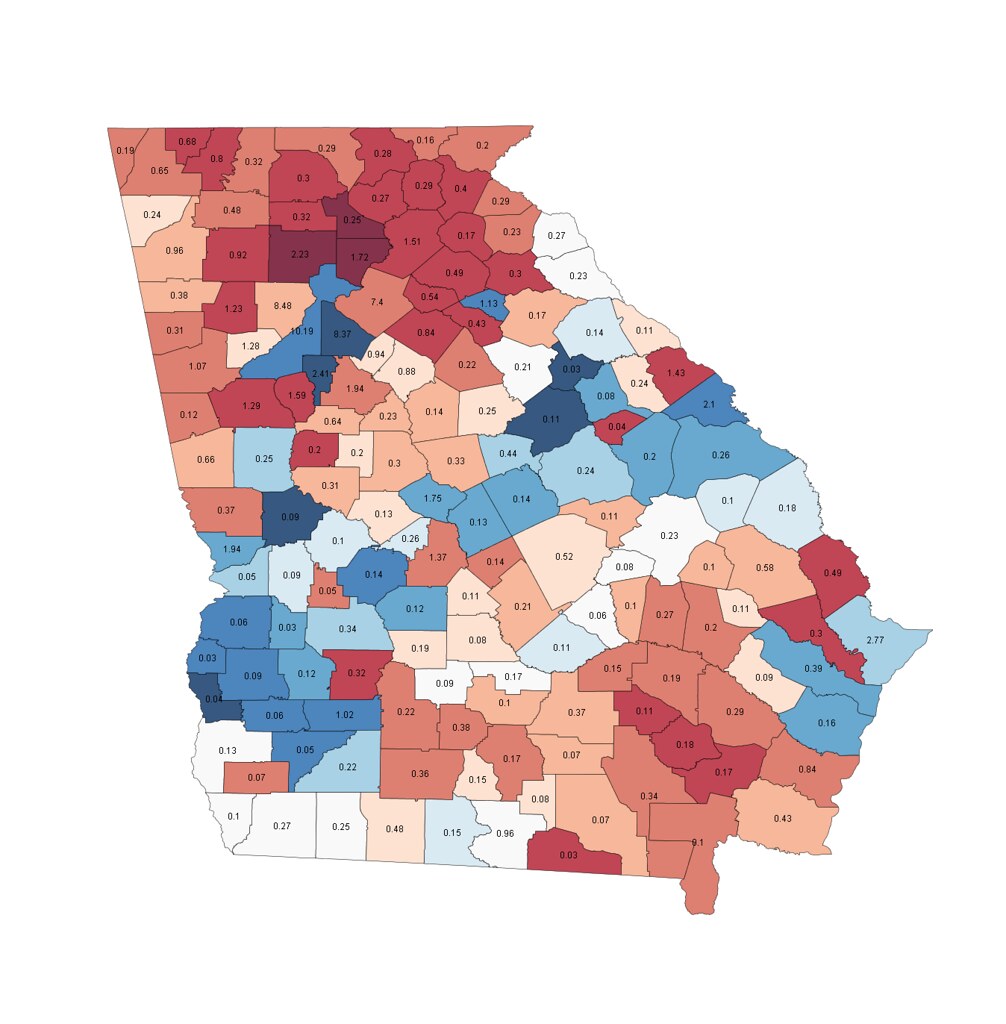
Races (538 Average/SSP Rating): President - Likely McCain (O 47.1, M 51.5) Senate - Lean Republican (D 46.6, R 50.7) House - GA-08 Marshall(i) v. Goddard (Lean D)
Counties to watch: Georgia is a very polarized state, unlike Florida, which had large counties that were white-coloured, all of the largest counties in Georgia are either red or blue, leaving the bellwethers as smaller, less predictable counties. Three to watch are Lowndes, Greene and Baldwin.
Baldwin is pale blue in the middle of the state, with 0.44 written in it. It is a typically close district, but it runs about 5 points ahead of the Democratic candidate state-wide. This 43% African-American county must surely give Obama or O2B Senate candidate Jim Martin at least 55% to suggest a state-wide win.
Greene County is just north of Baldwin, a white county with a label of 0.21, and it typically votes 60-40 for the Republican. When Max Cleland lost to Saxby Chambliss by 7 points statewide, he lost by 12 in Greene. If Obama/Martin have a chance in the state, they need to get Greene county to be a near tie. For the corollary, if you see either ahead or close in Greene county, buckle up.
The third county, Lowndes, represents, what is the main swing region of the state, and another place to closely watch, the southeastern edge, bordering on the Florida panhandle. While these look much more tossup than the panhandle just did, that is partially because Georgia is on average more Republican, so the panhandle region looks more mainstream in Georgia than in Florida. Lowndes, which contains Valdosta, is typically 60-40 Republican in statewide races, and if either candidate manages to split these counties, as Zell Miller did in the '94 Governor's race, then the the Obama campaign and the Martin campaign may just pull it out.
The 8th district, where Jim Marshall is again fighting off a tough challenge, this time from a former Air Force general, is a large district in the centre of the state, beginning in the pale red areas just south of Atlanta, and stretching to the pale red areas just north of Lowndes county. The largest part of the district is Bibb County, which contains Macon.
VIRGINIA
This page includes a map of county names
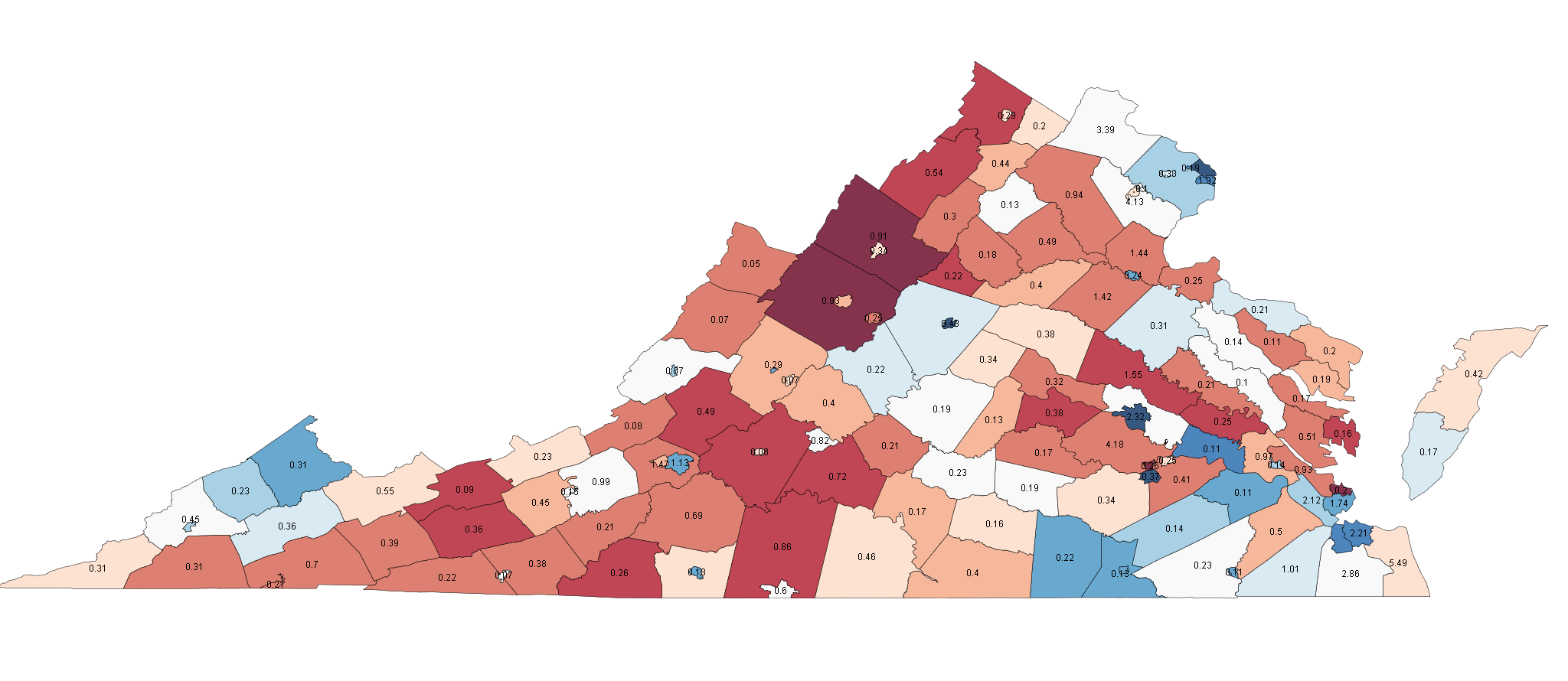
Races (538 Average/SSP Rating): President - Safe Obama (O 51.8, M 46.6) Senate - Safe Democratic (D 63.3, R 33.7) House - VA-02, Nye v. Drake(i) (Lean R), VA-05, Perriello v. Goode(i) (Lean R), VA-10 Feder v. Wolf(i) (Likely R), VA-11 Connolly v. Fimian (Toss-up)
Counties to watch: The one useful thing about Virginia's county/city setup, from an analysis perspective, is that it's somewhat easier to get a sense for how the suburban areas around cities are breaking. Indeed, the majority of the key swing votes in the state lie in these suburban counties. The most important areas are again, in the north, around Fairfax, the two white counties to the west and south, Loudon and Prince William County. Prince William, containing the independent city of Manassas, has voted within a point of each of the last three federal races in Virginia, and was a two point win for Jim Webb, and while Loudon County has lagged somewhat behind, it is also a fast growing area that tipped more to Webb than Kerry or Bush. Obama wins in this area suggest a win in the state, and large Obama margins suggest a fairly safe carry of the state.
Other swing counties fall outside Democratic city areas. Examples include the Chesapeake City area, south of Norfolk, which is slightly Republican, but close, and Henrico County north of Richmond, which was basically dead even in 2006. The western areas will generally be quite red, but remember that the small flecks of blue will typically be as large in vote size, if not larger, than than the wider areas. Still, Obama should pick up the handful of blue counties in the far west, and just focus on keeping margins down in the rest of the area. This race seems to me like it will be decided by growth and Democratic movement in the cities and suburbs of the North, and that's where to watch.
These Northern swing counties are also involved in two of the competitive House races, as the open seat in VA-11 covers a large part of expected Democratic ground in Fairfax and Prince William counties. VA-10 stretches west from Fairfax to the northern corner of the state, and while this includes some fairly red areas, most of the population of the district comes from Loudon County. If Obama/Warner voters take the lion's share of these counties, it will be good news for the Democratic House candidates as well. VA-05 stretches over the south-central area of the state, with some heavy Republican areas, but also stretching east to the Democratic counties on the southern border and north to the light blue counties around Charlottesville City. The swing counties that connect the two darker blue areas will be the key to tipping the district. The final competitive district is VA-02, which covers the two counties that look like an island here, but actually border Maryland on the Delmarva Peninsula. Northhampton in the south is blue-leaning, while Accomack is slightly Republican. Accomack is much more of the population of the district, though, so this will need to be very close for the Democrat to win.
**7:30 CLOSINGS** Two huge presidential swing states, with House races, and a senate and governor's race in North Carolina, which closes with West Virginia and Ohio.
NORTH CAROLINA
This page includes a map of county names
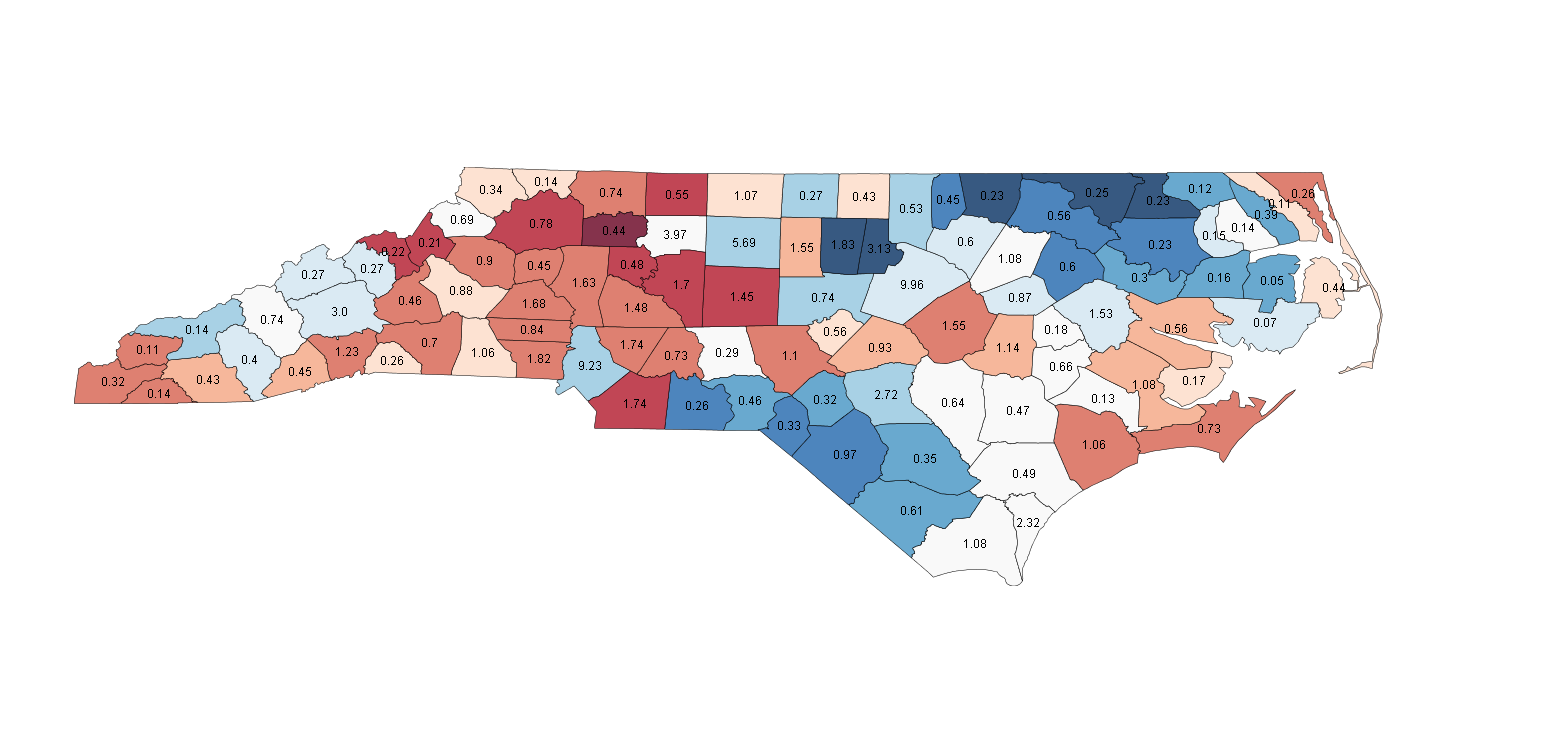
Races (538 Average/SSP Rating): President - Lean Obama (O 50.2, M 49.0) Senate - Lean Democratic (D 47.5, R 46.8) Governor - Perdue v. McCrory (Toss-up) House - NC-05, Carter v. Foxx(i) (Likely R), NC-08 Kissell v. Hayes(i) (Toss-up), NC-10 Johnson v. McHenry(i) (Likely R)
Counties to watch: The real key in the state, are the swing counties that run between the two heavily black Democratic areas in the north and south. Typically, to be blue a rural county in the west of the state has to have around or above 40% African-Americans. The white counties that run between the two main areas of African-American population are typically 5-10 points short of this, enough to keep Kerry and Gore above 40, but not much more. This includes New Hanover County, the furthest southeast, home to Wilmington, and continues north to the areas south and east of Raleigh. These areas typically run a little stronger relatively for Senate candidates than Presidential candidates, but Obama may need them to have a chance.
If African-American turnout is high, as it has been in early voting, these counties are where we may see it's effects in shifting counties from red to blue, along with the help of Obama's gains among white voters. Unlike black turnout in cities, which is typically harder to see, as it just turns blue bluer, these counties may flip if blacks can outperform their percentage of the population and, as Tom Jensen of NC based Public Policy Polling points out, it's also about a larger black margin, at least for Obama. Another factor Jensen points out is the shift in Wake County, Raleigh. This area has been trending blue in recent years, going near 50-50 for Kerry, and if this continues, big margins could help all three candidates. Winning Democrats in North Carolina tend to form a wall of Democratic counties between the coastal and inland Republicans, and if you see such a wall forming on Tuesday night, it should be good news for whichever Democratic candidate manages it.
The three interesting House races are all in the strong Republican centre of the state, a common theme in this Democratic year. Larry Kissel's NC-08 challenge is the best looking on the map, as NC-08 includes part of the Charlotte area in the south, then stretches to include some of the blue counties that should help Kissel build a margin. NC-05 and NC-10 are harder rated and tougher-looking, with almost no blue area in either. NC-10 starts just east of the blue counties around Asheville, and stretches across 70-30 Bush country until it stops just west of Charlotte. NC-05 is in the northeast corner, stretching west and stopping short of Greensboro, though it does include parts of the swing county of Forsyth, home to Winston-Salem. The winning strategies are basically the opposite, as Carter in NC-05 has to win the counties on the extreme east and west of the district while holding the centre, and Johnson in NC-10 has to win the pale red counties in the centre while holding off the red to the outside.
OHIO
This page includes a map of county names
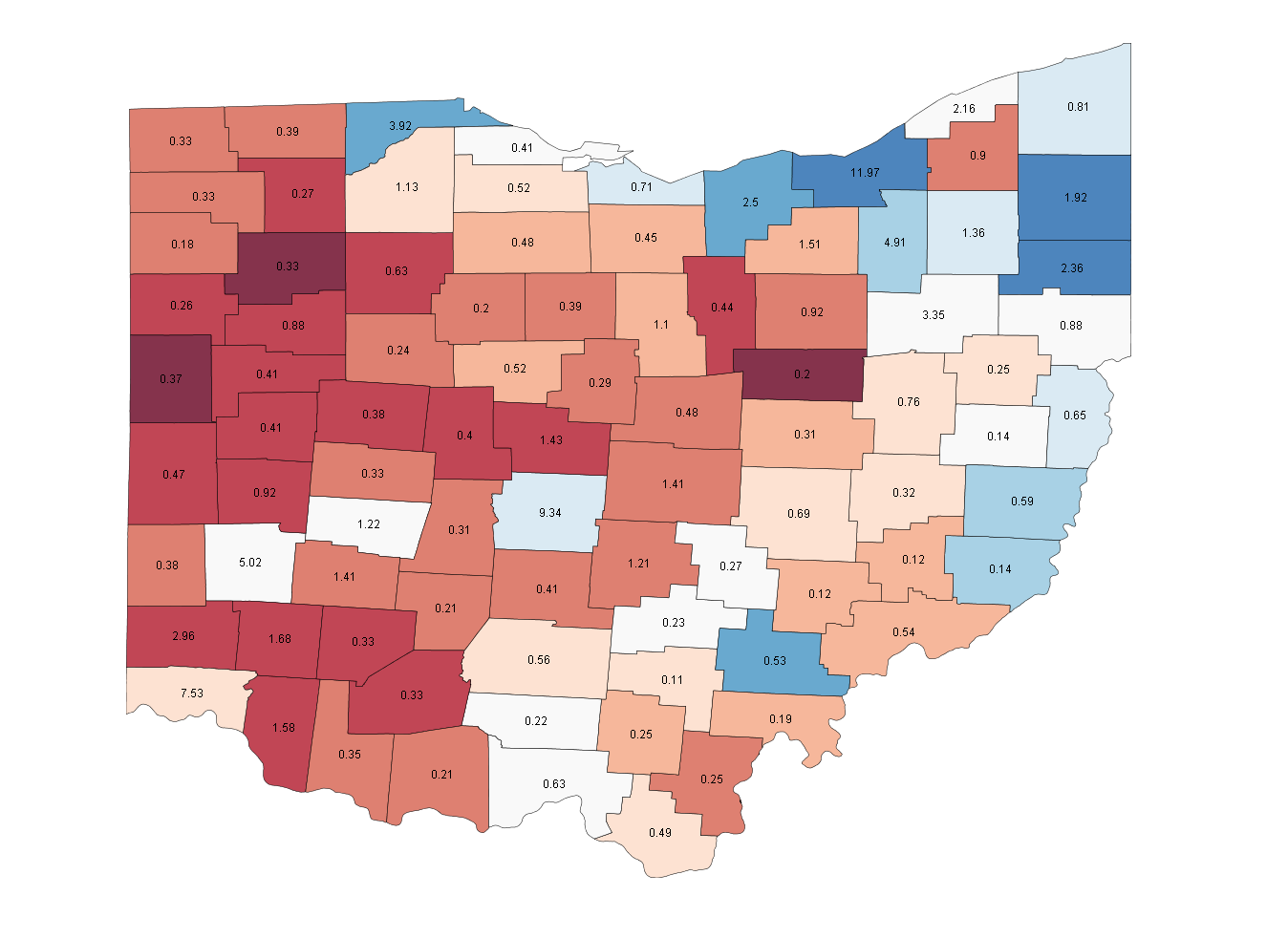
Races (538 Average/SSP Rating): President - Likely Obama (O 50.6, M 47.4) Senate - None House - OH-01, Driehaus v. Chabot(i) (Toss-up), OH-02, Wulsin v. Schmidt(i) (Lean R), OH-07 Neuhardt v. Austria (Likely R), OH-15 Kilroy v. Stivers (Lean D), OH-16 Boccieri v. Schuring v. (Lean D)
Counties to watch: There are two main swing areas, plus a couple of other counties to keep your eye on. The first are the white counties in the east of the state, just south of the darker blue Cleveland area, Stark and Columbiana Counties, containing Canton. These edge Democratic, and while Kerry split them, Gore won neither. An Obama win in both is a good sign, a split could mean another very tight race. The second are the two white counties surrounded by red in the west of the state. The westernmost is Montgomery County, home to Dayton and usually about a point or so Democratic, while the eastern one is Clark County, where Springfield tends to vote right with the state as a whole.
Some other areas to watch are the swing counties adjacent to Toldeo in the northwest and Cleveland in the northeast, and the small southern swing counties Scioto and Pike. Kerry won none of these counties, but was above 47.5% in all of them. Obama will need to flip at least one or two to take the state, and if he has them all, or big leads in a couple, he could breeze to a win.
As many as five house races could be close, with three looking like very good pickup chances, and four of the five are in the more Republican southwest area, though not the deepest red areas. OH-01 features 7th term incumbent Steve Chabot in trouble, with Democrat Steven Driehaus pushing in the heart of Cincinnati. This is a Republican area, but high African-American turnout in the city itself will help Driehaus. Mean Jean Schmidt is under pressure in OH-02, which stretches east from Cincinnati to those to southern swing counties that Obama and Victoria Wulsin may be counting on. The other three are open seats, with OH-07 stretching between the two white swing counties east of Dayton, OH-15 featuring a big chunk of the Columbus area that should favour Kilroy, but also the two deep red counties to the west, and OH-16 in the northeast part of the state, extending from a eastern bound of the swing county of Stark, or Canton, to the brick-red county to the west
**8:00 CLOSINGS** 18 states close at least partially. The ones I'm listing here are somewhat narrowed down, as only MS-SEN, MO-PRES and ND-PRES are statewide toss-ups, plus Pennsylvania because of the talk about it. I'm open to adding more of AL, CT, DE, IL, KS, ME, MD, MA, MI, NJ, OK, SD, TN or TX if people would like.
MISSOURI
This page includes a map of county names

Races (538 Average/SSP Rating): President - Toss-up (O 49.0, M 49.3) Senate - None Governor - Nixon v. Hulshof (Likely D) House - MO-06, Barnes v. Graves(i) (Lean R), MO-09, Baker v. Luetkemeyer (Toss-up)
Counties to watch: The first area is the sort-of "whiskers" to the far southeast, Mississippi, New Madrid and Pemiscot Counties. They get more progressively Republican as you move north, but these three counties are key to Democratic hopes. Kerry lost all three, while Gore won them and kept the election close.
The other key for a Missouri winner is what I like to think of as 'outstretched arms'. Essentially, a Democrat who wants to win in Missouri should be able to create a nearly contiguous line between St. Louis and either Oregon County, the pale red county on the flat portion of the southern border, or through to Kansas City, taking a couple of skips on the way. If a Democrat can be strong in St. Louis, make one connection and get close to another, they can win the state. McCaskill and former senator Robert Holden made the bottom connection and got close on the top, while Mel Carnahan came close on both, and all won. Gore has the traces of a connection to Kansas City, but wasn't strong enough in the KC area.
The final piece of the puzzle is the Kansas City environs, which are major swing territory. The four white counties just north of KC all went against Kerry but for McCaskill. If Obama is even in these it'll be close, but if he wins them he has a very good shot.
O2B candidate Judy Baker is competing in MO-09. This is a large district that covers much of the northwest corner of Missouri, and stretches as far south as the southern edge of the St. Louis area, but stays on the eastern border of St. Louis itself. The largest county in this district is the light blue, 2.78 labeled Boone County, home to Columbia. This area on the western edge of the district is where Baker must build up votes to win the race. MO-06 is another Republican district that goes from the Northeast corner down to Kansas City, again stopping short of the city proper, but including the four swing counties highlighted above. It also stretches east to border the 9th district. This battle will likely be fought and won in the areas around and in Jackson County.
MISSISSIPPI
This page includes a map of county names
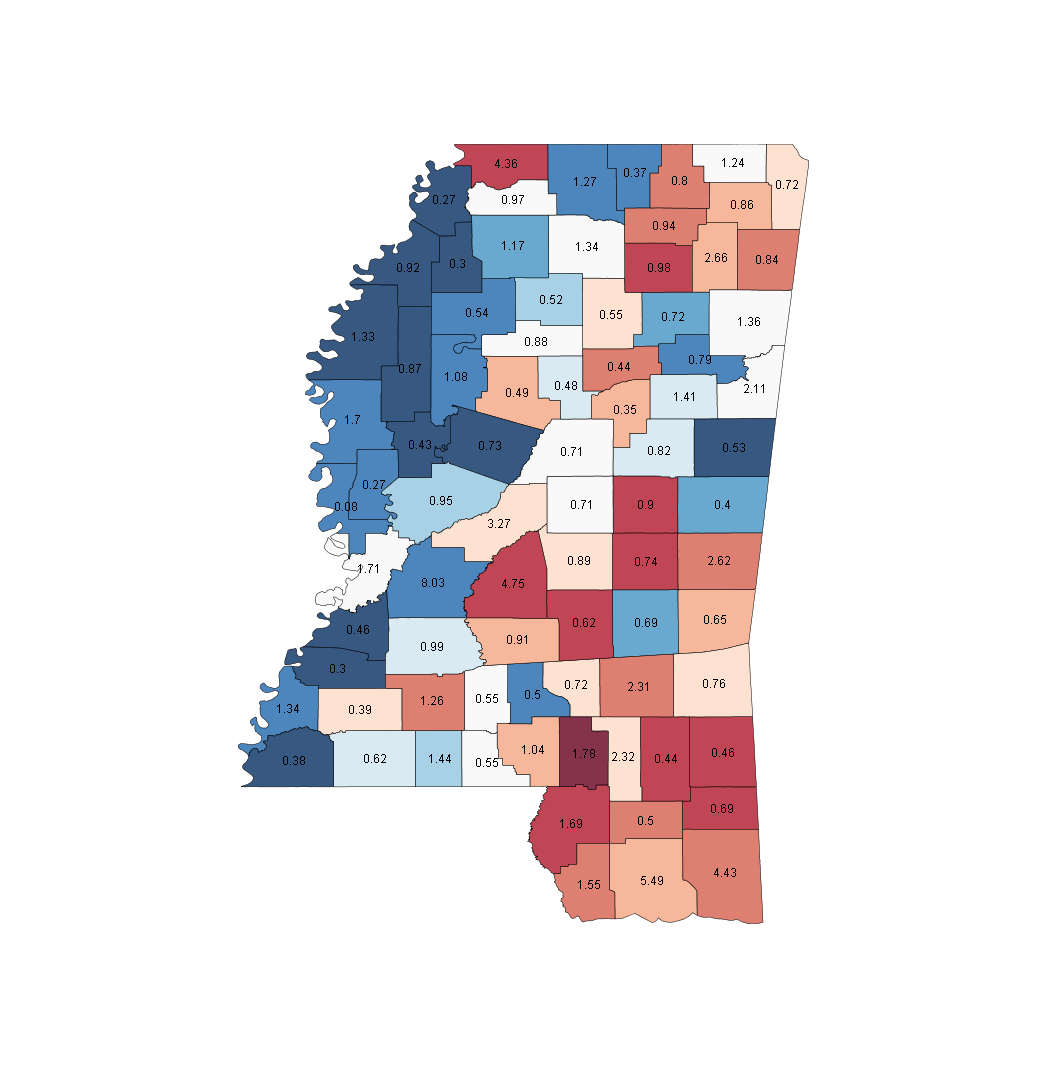
Races (538 Average/SSP Rating): President - Safe McCain (O 43.0, M 54.5) Senate A - Safe Republican (D 34.8, R 63.0) Senate B - Lean Republican (D 45.7, R 52.4) House - MS-01, Childers(i) vs. Davis (Likely D)
But there are some special notes to the special election. There is no party identification, only names. This is good for Musgrove's commercials, where not mentioning the D-word will only be a benefit with white voters, but given that he was a Democratic governor, he can't really hide his party that well. Also, I've wondered how this will play overall. While Musgrove will pick up low-info white voters who may not vote Democratic, but like him, and don't get the reminder of a D, will this be canceled out by the opposite from Black low-info Obama voters? Considering a similar proportion of voters are probably low-info in both demographics, it may give a slight edge to Musgrove, but not much.
**UPDATE: As we saw on the front-page, Roger Wicker is attempting to exploit this in African-American areas, quite a devious scum tactic, but potentially successful.**
Counties to watch: Looking at Musgrove's 1999 Gubernatorial win, and his 2003 loss, the difference is pretty simple, winning the northeast corner of the state. In 1999, the two corner counties, white Alcorn and pale red Tishomingo, along with the two white counties on the eastern border, Lowndes and Monroe, all went to Musgrove, along with some of their neighbours. In 2003, he lost these to Haley Barbour, and the state went with them. You'd have to think that to win this time around, he'd need to repeat the same thing. The two white counties at the dead centre of the state, Attala and Leake, are pretty solid bellwethers, and worth watching to see Musgrove's progress.
MS-01 is the northern part of the state, taking the area that is basically between the state border and a diagonal line connecting the northwest corner and the two eastern swing counties talked about above. When SSP previewed this race in May for the special election, they noted that Davis is from Memphis, and that was a bit of a negative for a lot of other areas in Mississippi proper. Childers looks pretty safe for re-election, but he'll need to build margin in the two blue counties in his district, Benton and Marshall.
NORTH DAKOTA
This page includes a map of county names

Races (538 Average/SSP Rating): President - Likely McCain (O 47.4, M 50.7) Senate - None House - None Close
North Dakota is a strange state, giving huge 30 points wins to George Bush, but huge 40 and 50 point wins to its two Democratic senators, so the map is at times somewhat inaccurate, just because the index can't really figure out what's going on in some counties. However, the two close races I did find a map for, Clinton's 6 point loss in '96, and Earl Pomeroy's 2002 House win, pretty much validated at least the general trends in this map, which again could mirror the one we see on Election Night. The three strongest areas are heavily aboriginal, with Rolette in the north, Benson the lighter blue just below that and Sioux County in the south all being very reliably Democratic, and also areas where we will see if Obama's outreach to voters on reserves is as effective as some think it may be. Beyond these areas, Democrats are stronger in the more populated east of the state, though in this case stronger means 60-40 Bush counties.
Counties to watch: To know if the race will be close, watch the east and the north, but especially the east, which has more people. In addition to the pale blue counties in the Fargo area, particularly Cass County, labeled 21.32 on the eastern border, Obama should be winning up and down the eastern border to have a chance at the state. In particular, he must likely win Cass County itself by at least a couple of points. If the county is blue early in the evening, things will be going quite well. The northern swing counties include Ward county, labeled '8.19' and containing the fourth-largest city, Minot. While the other large cities in North Dakota have more partisan lean, Minot tends to be a fairly even area, and with a decent chunk of the vote is another place Obama must at least stay close in if not win.
**8:30 CLOSINGS** Arkansas doesn't have much going on, I'm afraid.
**9:00 CLOSINGS** I'm going to tempt fate by keeping AZ in here, along with CO, MN, and WY. This leaves Louisiana, Nebraska (where NE-02 seems in play, though state polls don't suggest it), New Mexico, New York, Rhode Island and Wisconsin uncovered.
ARIZONA
This page includes a map of county names

Races (538 Average/SSP Rating): President - Safe McCain (O 46.0, M 51.7) Senate - None House - AZ-01, Kirkpatrick v. Hay (Likely D), AZ-03, Lord v. Shadegg(i) (Likely R), AZ-05, Mitchell(i) v. Schweikert (Lean D), AZ-08, Giffords(i) v. Bee (Likely D)
From a recent poll by Zimmerman % Associates, M 44, O 42
Maricopa County voters preferred McCain by a thin edge of 42.9% to 40.0% for Obama, while Obama enjoys a margin of almost 19 points in Pima County, beating McCain 53.5% to 34.9%. Arizona's other 13 counties, combined, give McCain a 51.8% to 37.3% advantage.
Counties to watch: An important thing to realize about Arizona is that while Maricopa County is a huge influence on the state, with nearly 60% of the voters, a Democrat can win the state without winning Maricopa, though only barely, as Janet Napolitano did in her 2002 Gubernatorial election. Maricopa typically favours the Republican by 1 or two points, so a tie or a 1 point loss could be a very close statewide Democratic win. By the same respect, if Obama is behind by more than a couple here, McCain will hold his home state.
Pima County, mentioned above, is the larger blue county on the southern border, with 20% of the voters, a state that the Democrat generally picks up around 52-53% in. the real key in the poll mentioned above is not Obama's number in the county, which is not remarkable, but McCain's which is very low. If undecideds break for Obama, he will at the very least outperform Bush. The dark blue county in the east is Apache, typically a 65-35 democratic county. This is a 77% Native American county (a voting bloc as Democratically loyal as African-Americans), with nearly 60% speaking Navajo in their homes. The size of the margins and size of the turnout in Apache County will be an interesting measure of Obama's ability to reach out and inspire aboriginal voters.
The open seat in AZ-01 will also benefit from any turnout increase, as it includes Apache County, but the majority of the population is in the western part of the district, surrounding the northern and eastern parts of Maricopa County. The key areas for the Democrat are obviously getting good numbers in the blue counties, but also to maximize results in the part of swing Pinal county southeast of Maricopa. AZ-03, with O2B candidate Bob Lord and AZ-05 are both within Maricopa County itself. Gabrielle Giffords in AZ-08 is in the Southeast corner, getting only parts of blue counties Pima and Santa Cruz, but this may be enough to lift her over the top.
COLORADO
This page includes a map of county names

Races (538 Average/SSP Rating): President - Safe Obama (O 52.2, M 46.3) Senate - Safe Democrat (D 54.7, R 42.7) House - CO-04, Markey v. Musgrave(i) (Tossup)
Not the prettiest map, a fair jumble, with Democrats sort of like the path of a drunk guy, as he walks south, lurching first to the west, then back to the east. The darkest of the dark red are mostly small, but the brick red areas just south of Denver (Denver is the blue 'squiggle'), are the really tough areas, Douglas and El Paso counties, large and very red, including Colorado Springs. The deepest blue is Costilla County, a heavily Hispanic area, along with the areas of Denver and Boulder Counties, which represent both cities proper, along with the University of Colorado. It'll be also interesting to note whether Obama's relative increase with Hispanic voters that seems clear in national polls will push some of the pale blue or white areas in the southern part of the state to an even deeper shade.
Counties to watch: It has to be counties, as there are four huge ones of interest that will give you a very good idea of how Obama (and Udall, though it likely won't be close for him) are doing. These are the four white counties surrounding the darker blue Denver and Boulder areas in the north. Broomfield, Larimer, Jefferson and Arapahoe county. They combine to have nearly 30% of the state's votes, and while Larimer is typically a point or so more Republican than the state, the others generally are good bellwethers. If Obama is posting even 55% in these counties, he will likely have enough to win the state.
In CO-04, Betsy Markey has a real chance, despite having a pretty red coloured district. CO-04 is basically an L-shape around the northwest corner of the state, but Markey's hope lies in the fact that the district is primarily centered around the lighter coloured Larimer and Weld counties in the north. Winning these areas strongly will be key for her.
MINNESOTA
This page includes a map of county names
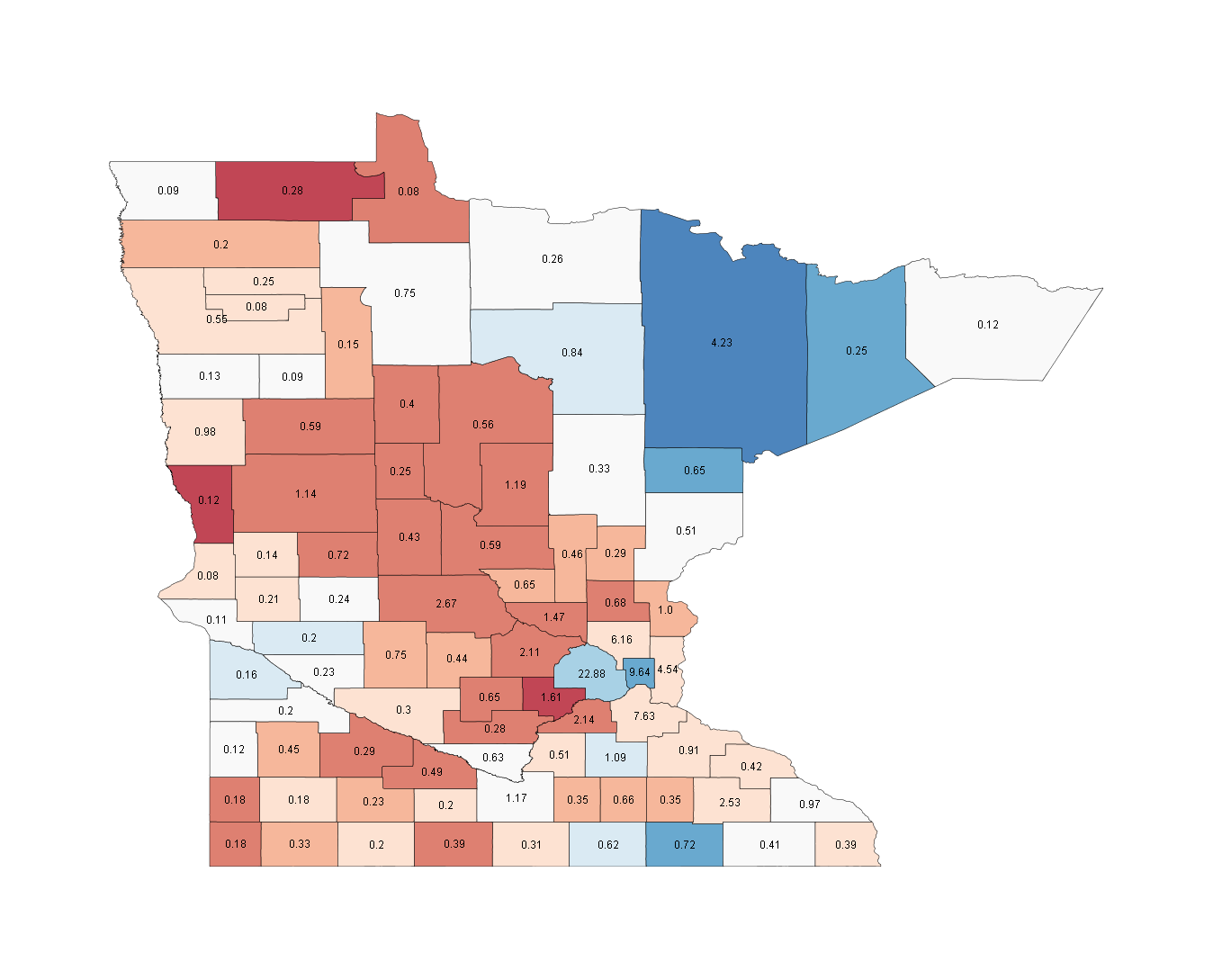
Races (538 Average/SSP Rating): President - Safe Obama (O 53.8, M 44.4) Senate - Toss-up (D 47.5, R 46.8) (538 does not have an Independent estimate) House - MN-01, Walz(i) v. Davis (Likely D), MN-03 Madia v. Paulsen (Toss-up), MN-06 Tinklenberg v. Bachmann(i) (Toss-up)
Minnesotans might be privy to the closest Senate race in the country, as radio host and O2B candidate Al Franken takes on not one, but two opponents, in sitting senator Norm Coleman and independent Dean Barkley. The good news for Democrats is that Obama should be safe, but the senate race could go to either of the two main party candidates. Barkley briefly held this very seat after the tragic death of Paul Wellstone, but did not contest the Mondale-Coleman race that followed.
First, a quick discussion of party strongholds. The two smaller blue counties in the east, Hennepin and Ramsey, are Minneapolis and St. Paul, and they are comfortably Democratic, delivering around a 60-40 Kerry vote in an overall 3.5 point win. The other key Democratic area is the large blue counties on the eastern 'peninsula'. The largest and darkest is St. Louis County, home to Duluth. When Republican Arne Carlson earned re-election to the governor's post in 1994, those three blue counties were the only Democratic ones in the state. In contrast, there are no deeply Republican areas, just moderately so. There were a few 70-30 Bush counties, but only two or three, and they tend to be more favourable to senate candidates. The major one is in the southeast part of St. Paul, Carver County.
An important thing to realize about Minnesota is the strength of the independent vote, as we can see in the Senate Race. Nader had 5% in 2000, Perot had a quarter of the vote in '92, and of course, Jesse Ventura was governor. While Barkley is a wild card factor, though, we do know that he has run for senate twice before. In those races, his support came most strongly from the areas around the Twin Cities. While Barkley ran above average in Hennepin and Ramsey Counties, his strongest showings came in the pale red and white states ringing the main population zone, especially to the northeast. Overall, it's not clear to me at first blush if he hurts Democrats more than Republicans, but given that his numbers are lower in the more Republican west and northwest, it seems a strong possibility.
Counties to watch: A few groups here for a tight race. The first is the white counties just west of the large blue area in the north, Aitken, Beltrami, Pine and Koochiching Counties. These tend to run around a point or so behind the Democrat state wide, but I haven't seen a map for a Democrat who won without at least one or two of these counties. The southern ones are prime Barkley territory, so watch to see what kind of numbers he pulls and who from. Beltrami is notable for being 20% aboriginal, and it will be interesting to see if the outreach Obama has attempted in states like New Mexico also will happen in Minnesota, and whether it can benefit Franken at all.
The second group are the white counties to the south-west of the state. Of these, Big Stone county, the furthermost west, is a strong predictor of the overall result. A winning Democratic map typically has a cluster of a few blue counties surrounded by the red counties ringing the area.
Finally, watch Blue Earth and Nicollet counties, just southwest of St. Paul. Again, these run a little behind, and a Democrat can win without them, but if the range here is more than a couple of points, to the Republican, Franken is in trouble.
The last two groups are generally poor to average Barkley areas, but if Barkley is as high as 15%, which would be his best state-wide showing, things could get chaotic.
In addition, no less than three house races will occupy our time in Minnesota. The big one on dKos and the netroots in general is, of course, MN-06, where many Dems are hoping for a takedown of Michelle Bachmann. MN-06 rings around the top half of the two blue counties that make up the Twin Cities, and tails off to the west, stopping halfway through Stearns County, the sort of Nebraska shaped county labelled 2.67. The good news for El Tinklenburg is that much of the vote is in the more Democratic friendly east, while the western areas, which were 60-40 Bush counties in general, are also smaller.
In MN-01, covering the whole bottom half of the state, Tim Walz should hold his seat. He will be keying on the southern Democratic areas, as well as the two southern swing counties mentioned above. In MN-03, Ashwin Madia is in a tight race to take the seat, which is located in light blue Hennepin county. The good news is that if the polls are correct, this should be at least a 60-40 Obama area, and that can only help Madia.
WYOMING
This page includes a map of county names
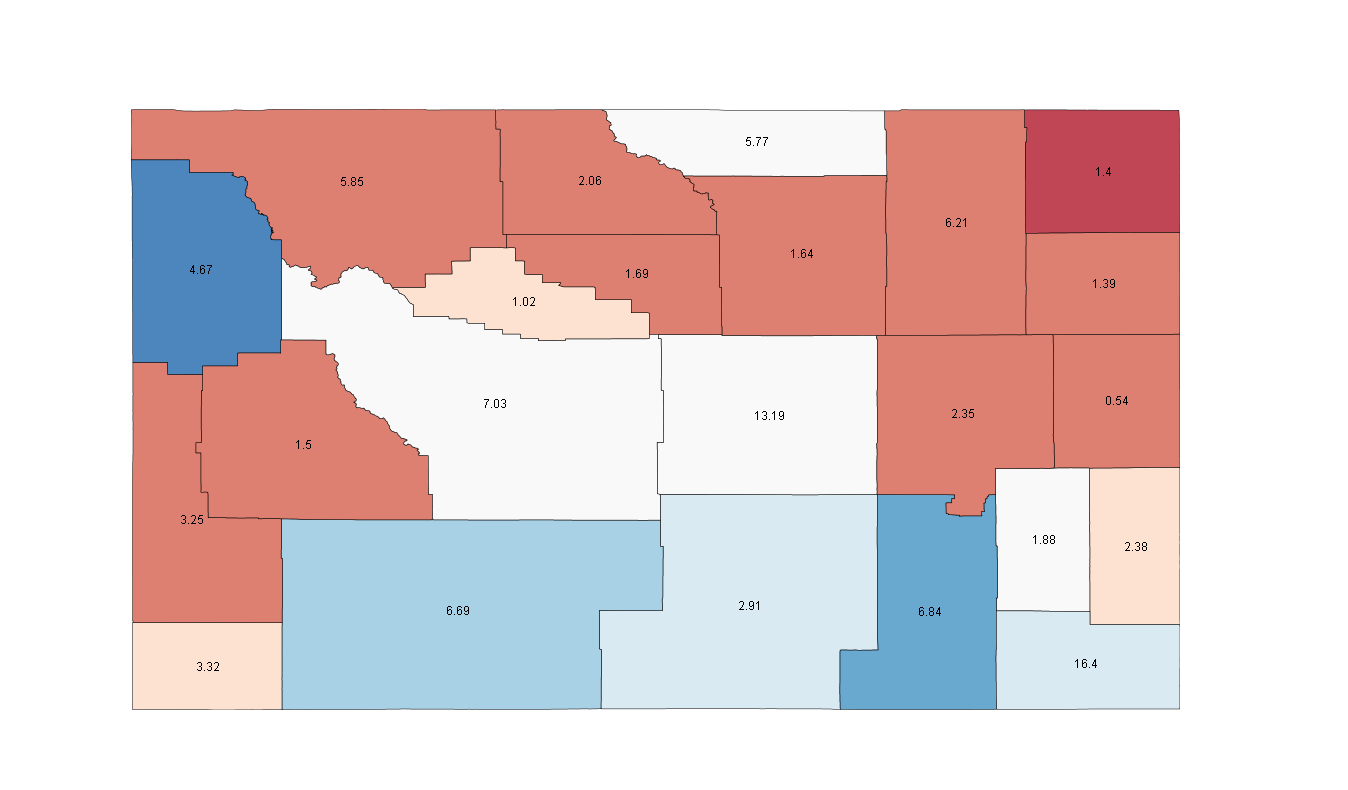
Races (538 Average/SSP Rating): President - Safe McCain (O 36.9, M 61.2) Senate A - Safe Republican (D 29.6, R 68.0) Senate B - Safe Republican (D 33.4, R 64.1) House - WY-AL Trauner v. Lummis (Lean R)
This is another state that will quietly, at least on the Presidential and Senate level, show its desire for change, as a good Obama night could see him out-poll Kerry and Gore by nearly 10 points.
But the big race here is the at-large house race, for O2B candidate Gary Trauner, who came only a thousand votes shy last time, out of more than 200K total votes. Given that this has typically been a blowout state, it's hard to really get a sense of where the race will be, but fortunately, we have Trauner's 2006 race to analyze.
Counties to watch: Trauner built up good margins in the blue areas, especially Teton in the west, Albany, the darker and Laramie, the lighter in the southeastern corner, and Sweetwater in the southwest. His weaknesses were also as expected, along the northern and western borders. In the white county right at the dead centre of the state, Natrona, Trauner overperformed what this model expects somewhat, and claimed a solid win there, so if you see that on the big night, don't get too excited yet. The other three swing counties, along with the pale blue in the south, Carbon County, were very close. The swing county that snakes its way to touch two areas of Democratic support in the west, Fremont, was a 69 vote difference for Trauner. With the race looking similarly tight in the polls this year, if any of the swing counties, excepting Natrona, look like they are breaking for Trauner early, he will have a serious shot. His presidential anchor is less than previous candidates have had, but increased presidential turnout may also hurt him in a typically red state, as less active voters who are more likely to be Republicans may show up more.
**10:00 CLOSINGS** Closing here are two close states, MT and NV. Other closings include parts of Idaho, Iowa and Utah.
MONTANA
This page includes a map of county names
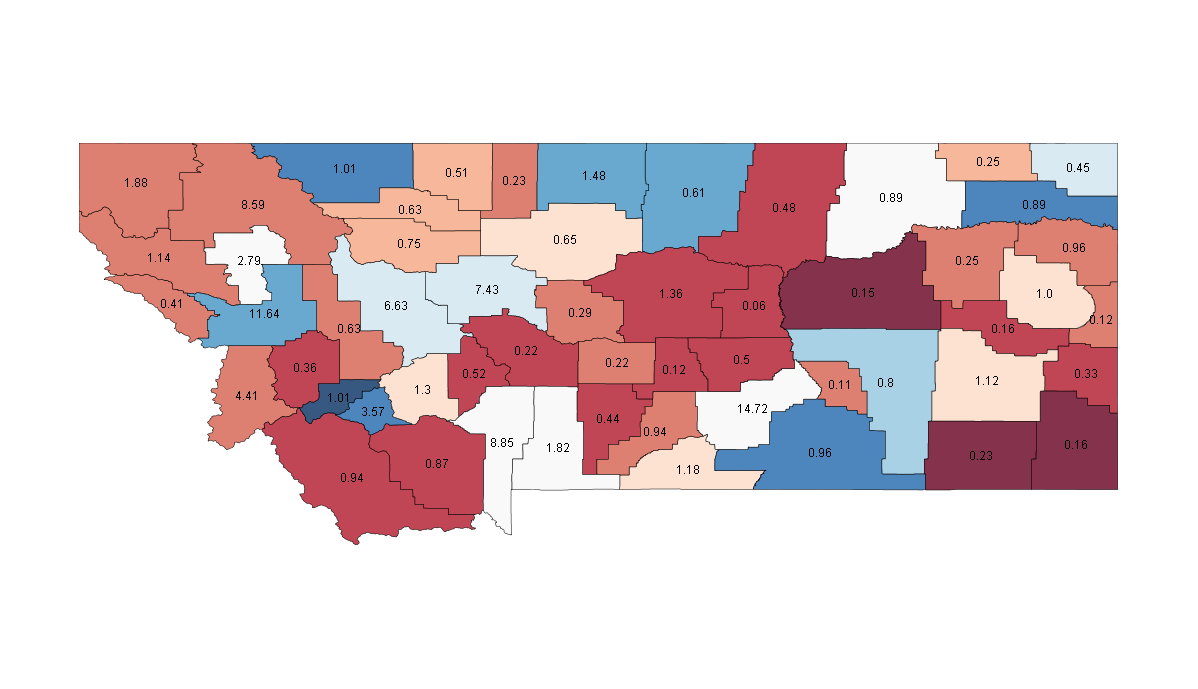
Races (538 Average/SSP Rating): President - Lean McCain (O 47.7, M 50.0) Senate - Safe Democratic (D 66.4, R 31.1) House - Not close
The only real question in this race is presidential, as the house and senate seats, along with the governor's mansion, are solidly Democratic. It's a state with a large independent streak, as it had the largest percentage of Perot votes in the country in 1992, which allowed Clinton to win it, the first Democrat since LBJ. Obama is polling just behind, but how does he take and win it? Probably the way Jon Tester did, which mirrors this map well.
Democrats are strong in Missoula in the west, home of the University of Montana, along with Butte, just southeast of Missoula. Another key area of strength is the aboriginal vote, as four of the five blue counties on the state's borders are majority aboriginal counties. If Obama can win these 60-40, or better, he may have a good night in the state. The brick and deep red counties are very tough ground for Democrats, many of these are 75-20 Gore/Kerry counties or worse, and the Republicans are solid in the fairly populous northwestern part of the state.
Counties to watch: Two of the three largest counties in the state are very close swing counties, and in both Tester was near even with Conrad Burns. These are Gallatin, on the southern border and projecting south into Wyoming, home to Bozeman, and Yellowstone County the central white county forming a barrier between a deep blue and a deep red, which is Billings. Keeping it even here will allow Missoula, Butte and the reserves to push Obama over the top.
NEVADA
This page includes a map of county names
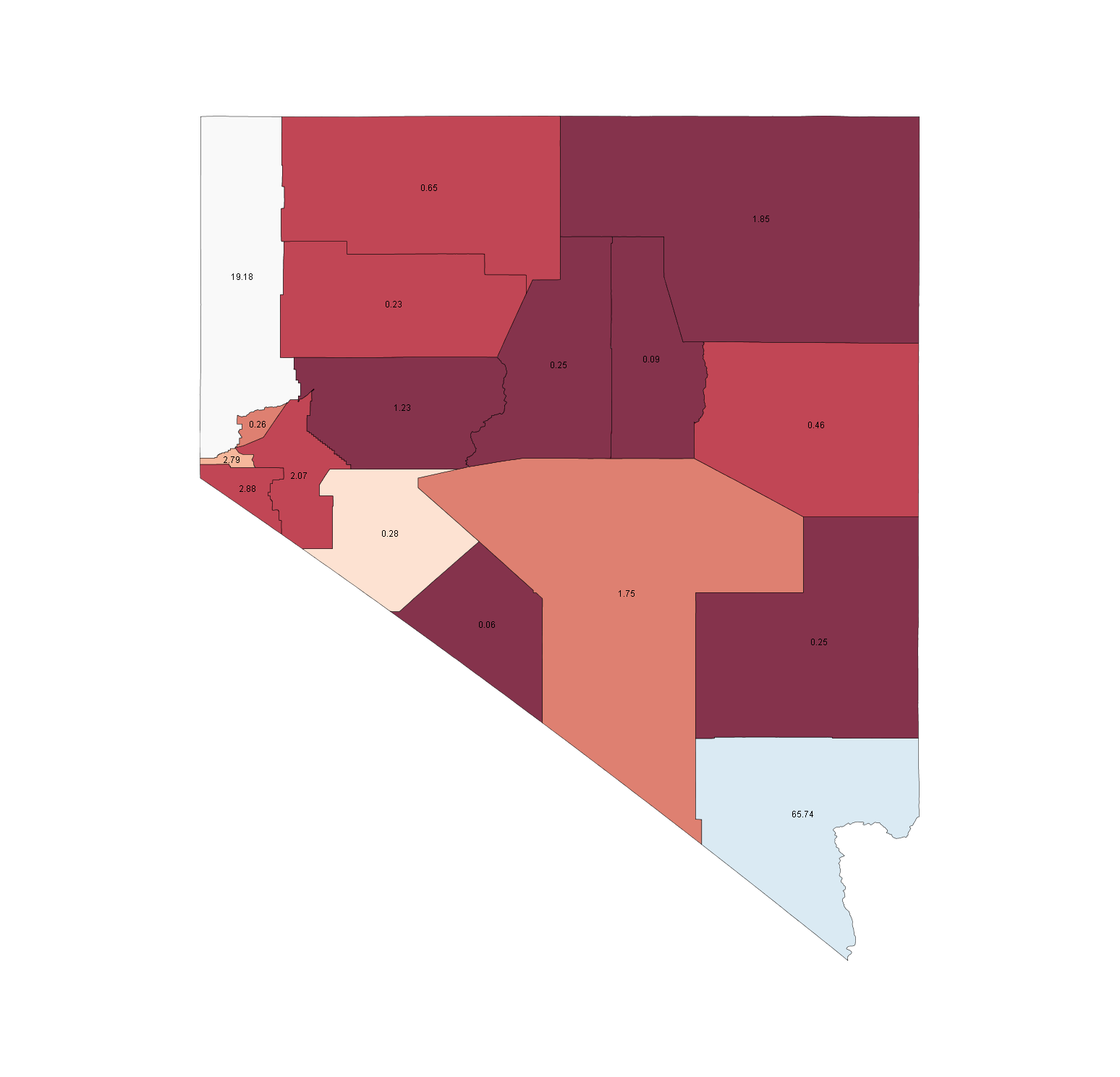
Races (538 Average/SSP Rating): President - Likely Obama (O 51.1, M 46.9) Senate - None House - NV-02, Derby v. Heller(i) (Lean R), NV-03, Titus v. Porter(i) (Toss-up)
If you're a night owl like myself, or a west coaster, you may have been following Higher Pie's early voting diary on the state of Nevada. From his diary, a note of the import of Nevada's counties.
Why just Clark and Washoe?
87% of Nevada's registered voters live in Clark+Washoe. The other 13% are very red, but if Obama can carry ~53+% of Clark+Washoe, he'll win Nevada.
I couldn't have put it better and more succinctly than that. Clark County in the southeast has more than 65% of votes, but still tends to be around 4 points favourable for the Democrat, showing the other 35% is quite red. Another nearly 20% of this is the western white county, Washoe, though this tends to run a little behind the Democrat across the state, though it is trending blue. Much of the rest of the state is either 70-30 or 75-25 Bush counties, with Carson City, the small light red county south of Washoe and Nye county, the large light red on the southwest border, and home to the controversially proposed Yucca Mountain nuclear waste site, as the most notable exceptions.
Counties to watch: Unlike in neighboring Arizona, where a Democrat can closely lose Maricopa county and still win, in Nevada there is no margin for error. Obama must win Clark County, probably by at least 4 points, and keep the margin at worst even in Washoe, to carry the state. A tie or loss in Clark will be give John McCain the electoral votes. The other counties are not really consistent enough to the state average to be bellwethers.
There are two interesting congressional races. NV-03 has Dina Titus trying to win a Clark County district that does not include Las Vegas proper, but stretches out from the centre of the county like a three petaled flower, reaching the southern, eastern and western edges. But spare a thought for Jill Derby, who is racing for NV-02, which is the entire non Clark County part of the state, plus part of Clark County. Harsh. This is a heavily Republican area, but even here, there is a dominant county, as the Washoe and Clark County areas of the district contain more than 50% of the voters. Washoe will be the main focus for Derby to take the seat, which is certainly a possibility.
**11:00 CLOSINGS**
California, Hawaii, Oregon and Washington close, with three close races, but none at the Presidential level.
CALIFORNIA
This page includes a map of county names

Races (538 Average/SSP Rating): President - Safe Obama (O 59.2, M 38.1) Senate - None House - CA-04, Brown v. McClintock (Tossup), CA-11 McNerney(i) v. Andal (Lean D), CA-46, Cook v. Rohrabacher(i) (Likely R), CA-50, Leibham v. Bilbray(i) (Likely R)
This state won't be a problem for Obama, who could conceivably sweep all but two or three coastal counties and make inland gains as well, especially in the south. Obviously, Proposition 8 is the other big battle here, and looking at the polling, an interesting, but unsurprising trend develops. While whites, Independents and Republicans have about the same percentage for Obama and No, Blacks and Hispanics are basically split on the measure, and, ironically, turnout increases, especially in a mostly-minority area like Los Angeles, may boost Obama's number and save the Mormon agenda.
County to watch: Imperial County, the white spot at the extreme southeast of California, is an interesting one to gauge the effect of the Latino vote. 72% in this county are Latino, and 66% speak Spanish as their first language, and while Obama will win it, it is not a major Democratic stronghold. If, as polls suggest, both California is an Obama romp and Hispanics move towards the Democrats, Obama could win this by as much as 25 points, where Kerry won by only 6.
O2B candidate Charlie Brown is a good man (Sorry), but is running in a tough district, as CA-04 covers the northwest of the state, stretching in a thin column down to El Dorado county (the red 0.7 right at the 'elbow' of the state'. To win, Brown will have to build large margins in the south, as the northern areas are quite inhospitable to Democrats. The good news is that most of the people live in the southern part of the district.
Los Angeles, which I didn't even mention, has almost a quarter of the state's vote, and typically sends around 2/3 of that to the Democrat. It is on the power of LA voters that Democrats can absorb losses in many other parts of the state. Also, watch the Prop 8 number here, as this is where it will live or die, I suspect.
OREGON
This page includes a map of county names

Races (538 Average/SSP Rating): President - Safe Obama (O 56.4, M 41.5) Senate - Likely Democratic (D 51.0, R 46.0) House - OR-05, Schrader v. Erickson (Likely D)
The most recent SUSA poll of the state suggested that Barack Obama already had nearly 45% of the statewide vote banked, thanks to Oregon's vote-by-mail system. He can lose 4 of 5 voters who haven't voted yet and still win the race. The same is not true for Senate candidate Jeff Merkley, who polled 12 points lower from opponent Gordon Smith. The good news is that he is still polling ahead, and most of the remaining voters say they are Obama/Merkley.
Al Gore won the state by 0.4%, and John Kerry by 4%, but they both won the same 7 counties, the five most northernmost, including the deep blue of Multnomah County, a 70-25 Kerry county containing Portland, and the three blue counties at the Pacific coast about halfway up the state. This looks like it could easily be the result for Merkley as well, with perhaps the only flipping county being the white county on the coast, Tillamook. With a 15 point margin, though, Obama looks set for a map that looks more like a Perot-aided Clinton '96, pushing to the west of Portland and also into Jackson County and Medford in the south of the state.
Counties to watch: The four white coloured counties around dark blue Portland are the key, especially the two largest, Washington in the east and Clackamas in the west. Gore and Kerry both got away with losing Clackamas and the county on the coast, Tillamook, but the margins were less than a point of Gore and less than two for Kerry. The other two swing counties in the area typically favour the Democrat slightly. If Merkley is winning the eastern three or all four, he is in very good shape for the win. If he is losing either of the central two, he is in some trouble. Even with wins in two or three of the swing counties, though, margin matters, especially if there are many Smith-Obama voters in these areas, which have favoured Smith somewhat in the past.
The interesting House race should be a Democratic hold of an open seat in OR-05, which streches from Clackamas county through the two light red counties to the west, then widening to encompass Tillamook and the southern blue county, Lincoln. Kurt Schrader should hold the seat, building his margins on the coast and the Portland area.
WASHINGTON
This page includes a map of county names
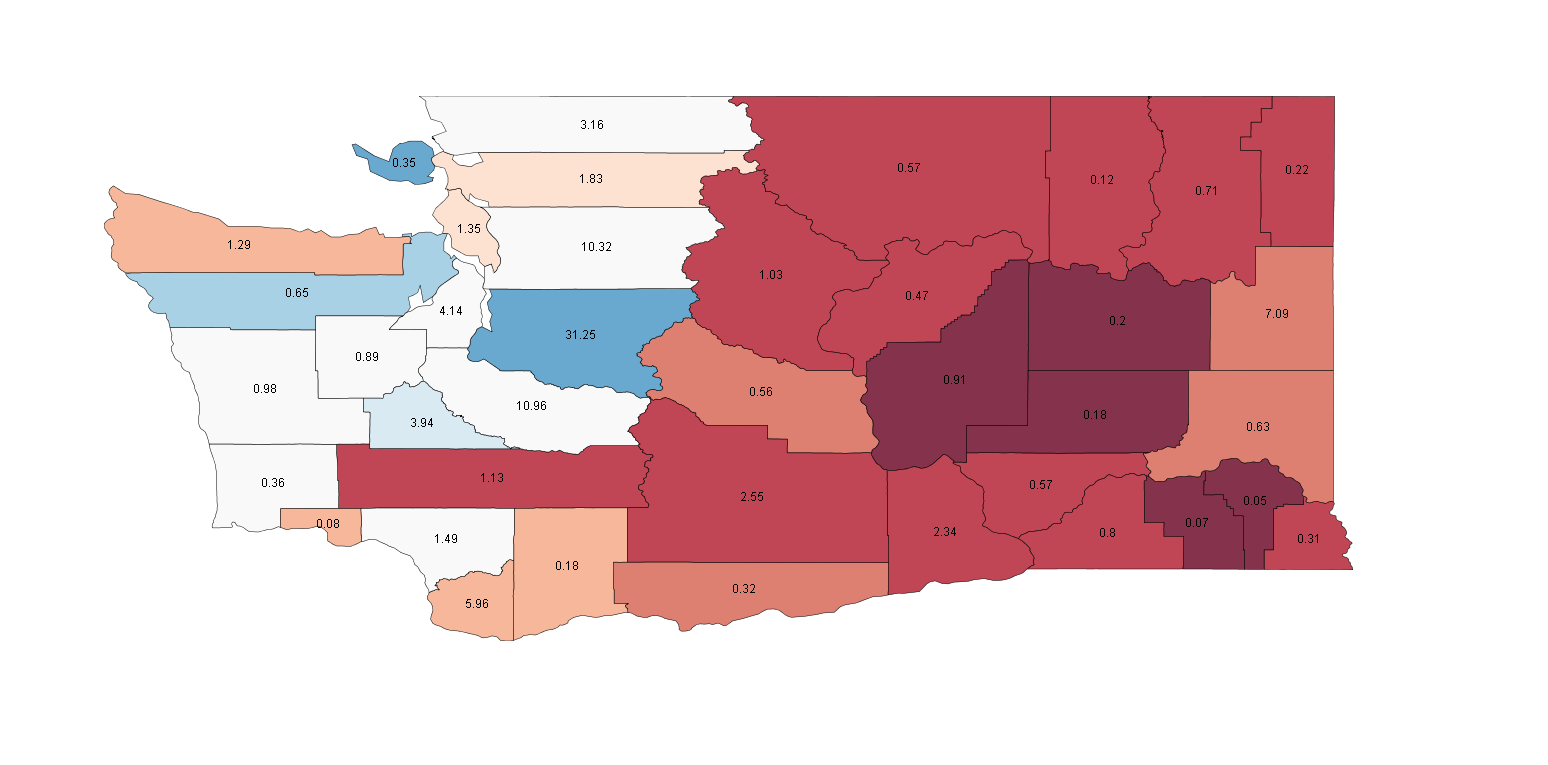
Races (538 Average/SSP Rating): President - Safe Obama (O 56.2, M 41.7) Senate - None Governor - Gregoire v. Rossi (Toss-up) House - WA-08, Burner v. Reichert(i) (Toss-up)
Washington is a state that went for Gore and Kerry by single digits, but current polling suggests no such close race for Obama, as John McCain has failed to crack 40% in three of the last six statewide polls. The real race, though is for the governor's mansion, featuring Christine Gregoire against Dino Rossi, in a race that was decided by 130 votes out of more than 2.5 million last time around. A recap of the epic recount battle is here, but the good news for Gregoire is that recent polls have her slightly ahead, while in 2004 SUSA's last poll showed her well back. So, there is a likely map for this race, and in 2004 of the 8 swing counties, each candidate won 4, and all were within 4 points.
The main area of Democratic strength in the state is King County, a 65-35 Kerry county, home to Seattle and many of the state's voters. Increases in turnout here can boost Democratic vote as much as winning the swing counties, so the margins here are critical. Like Oregon and California, the eastern part of the state is much more Republican, with some 70-30 Bush counties, but all of the deep-red and brick-red counties combined have about as many votes as either swing county flanking Seattle.
Counties to watch: The fact that my index picked out the 8 closest counties in 2004 Governor's race, when it doesn't have data for that race, and only one data set from the 2004 election in the state, is quite heartening, and also gives you a good idea of where to watch. Part of the problem for Gregoire last time was that while she won 4 swing counties, she lost the three largest, especially fast-growing Snohomish, north of Seattle, and Pierce south of Seattle. Improving the couple of points needed to make these counties even slightly blue would be enough to take the race in such a close battle. Should that not happen, the battle will turn to the other swing areas. Just west of Seattle, Kitsom and Mason were Rossi counties, while Gregoire won in the west, the south, Cowlitz County, and the north, Whatcom County. However, only one of these four wins was by more than 2%, and, failing larger gains in the Seattle area, these margins will have to expand. If you see Gregoire losing any of those four key counties that she won last time, there could be trouble.
The main house race is Darcy Burner and Dave Reichert's rematch in WA-08. Reichert didn't reach 52% in either previous election of his, but Burner just fell short last time. WA-08 covers the western part of Kings County and Pierce County to the south, but this does not include more Democratic areas of the heart of Seattle, and the district has never elected a Democrat since it's creation. Still, the area is turning blue, and Pierce County will likely deliver around 55% for Obama, which can only help both Gregoire and Burner.
**12:00 CLOSINGS** Only part of Alaska, for which I have no map, but a discussion.
ALASKA
Races (538 Average/SSP Rating): President - Safe McCain (O 43.1, M 55.3) Senate - Safe Democratic (D 55.3, R 42.9) House - AK-AL, Berkowitz v. Young (Lean D)
While Alaska does have 'voting districts', I have neither maps nor complete data for these, so they will not feature here. However, I would suspect that Begich would pull strong support from Anchorage as a former mayor, and the major Democratic area would be Juneau, the only district that Gore carried in 2000. At the state level, Democrats represent all the districts on the northern west coast, and this may be another Democratic area. However, major news media won't give even this poor level of granularity.
Finally, just for some tounge-in-cheek fun with the extremes, my ten best Obama county projections:
- Starr County, Texas, 83.79% - This one looks like an outlier to me, but who knows?
- Claiborne County, Mississippi, 84.64%
- Menominee County, Wisconsin, 84.76%
- Jefferson County, Mississippi, 85.69%
- New York County, New York, 86.03%
- Petersburg City, Virginia, 86.11%
- District of Columbia, 86.32% - This is far, far too low. It had 89% for Kerry/Edwards, it'll well over 90% for Obama.
- San Francisco County, CA, 87.88%
- Bronx County, NY, 89.29%
- Shannon County, SD, 90.05%
All in all, I expect a close race, but I hope Shannon County, one of the poorest counties in the nation, and contained on a reserve belonging to the Oglala Sioux Nation, pulls it out.